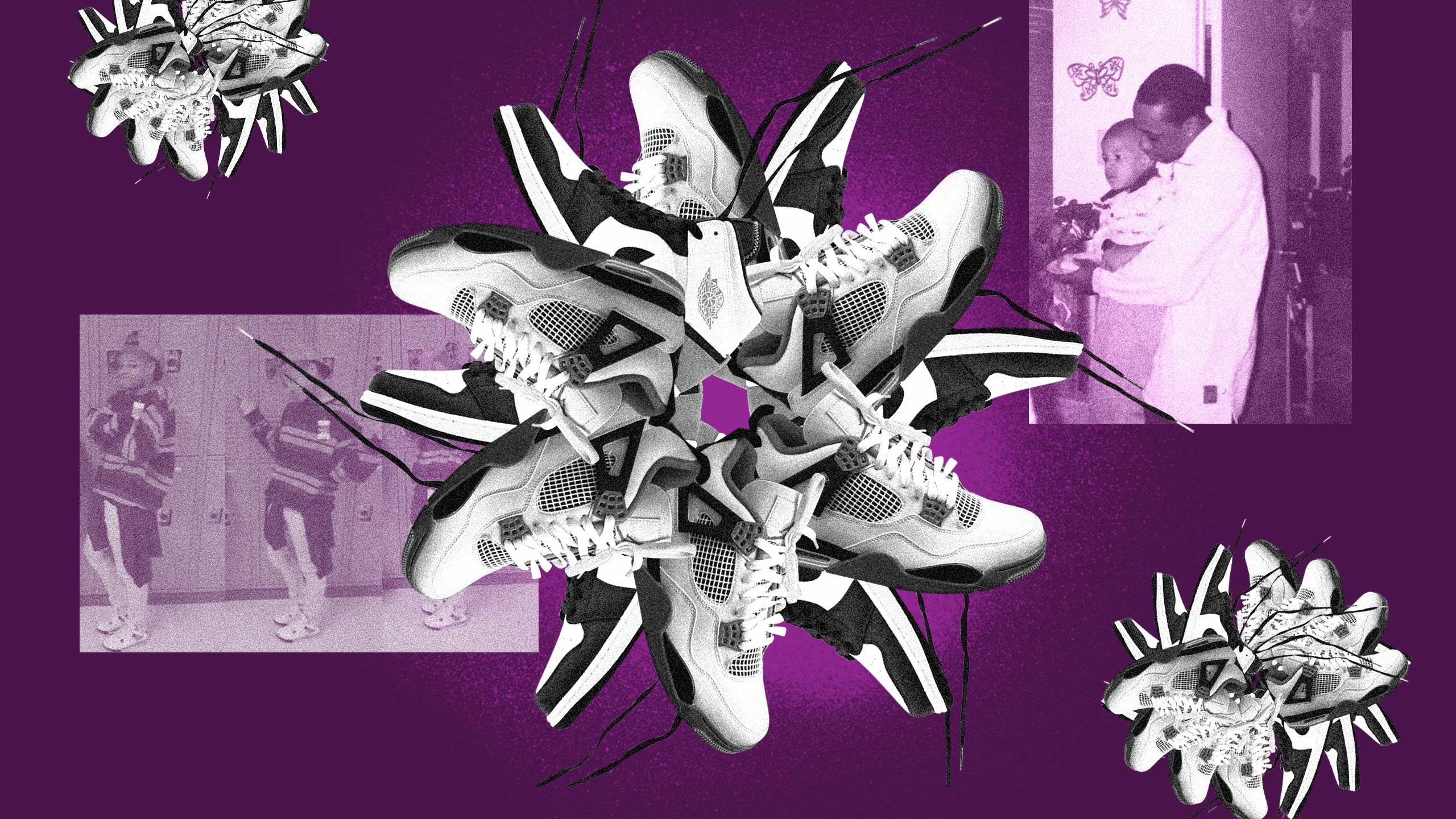The year is 1990. In Dallas, Texas, a basketball hits the pavement as another neighbourhood kid tells 14-year-old Willie Harris to “check-up.” Willie catches the ball and begins to dribble, his run-of-the-mill Fila sneakers gliding across the blacktop. He drives toward the hoop then stops, launching a three-point fade away. Time slows as everyone stares at the ball with anticipation. Swish! It tips off the rim and into the net. Willie, in cutoff warm-ups and a Larry Bird Boston Celtics jersey drenched in sweat, is momentarily frozen in awe after making the shot. Then he leans down, dusts off his Filas and leads the other kids in celebration.
I grew up hearing this story from my dad about being the only Black kid in the hood with flair and swag. He often called it a pivotal moment in his origin story as a sneakerhead and lover of streetwear. Little did he know, his stories sparked my own love of sneaker culture. And though I didn’t know it then, he was also introducing me to something that would save me years later.
“I grew up hearing this story from my dad about being the only Black kid in the hood with flair and swag.”
Growing up, every Saturday morning sneaker release was a mission of immense proportions: Helping my dad prepare to camp out the night before, working shifts waiting in line or getting raffle tickets so his chances could increase. We didn’t have a lot of money but sneakers were a form of escapism for us, one of the ways we could love on ourselves without going too far beyond our means. As a family, we were so into the world of sneakers that at cookouts my brother, cousins and I thumbed through the latest Eastbay catalog trying to guess which new pair my dad might get. As I grew to cherish what a new pair of shoes could do for my self-esteem, I worked out a deal with my dad that if I could put up half the money, he would cover the rest. I sold candy and drew portraits of kids at school to make up my contribution, and he kept his part of the deal every time. I appreciated each pair because sneakers were our father-son thing.
We bonded through the shoes we wore. I soon began to feel like I was a part of something bigger; there was a whole world of possibilities beyond Dallas. Scouring sneaker history blogs and style guides on Tumblr, I found a vibrant community of folks who similarly loved their footwear, though their geographic location meant they used different terminology. No matter if they were called tennis shoes, trainers, kicks or sneakers, everyone had a flair all their own, which let me know at an early age that I could have my own flair, too.
My love for and interest in streetwear and sneaker culture grounded me in my formative years because it was the only time I felt truly like myself. As a child, I never fully fit in with the neighbourhood boys. Though I played football with them and roughhoused at the park, I felt like I was on autopilot, like I was doing what was expected of me. In my gut, I was a “tomgirl,” my personal spin on the term tomboy that perfectly encapsulated my aversion to stereotypically masculine activities. But through streetwear and sneaker culture, I could blend both masculinity and femininity into a comforting, warm hug of acceptance.
I now have better words to more clearly describe what I was feeling at the time. But being raised in a Southern Baptist Black household and being anything other than what was perceived as “normal” was not acceptable. Being queer was out of the question. Yet sharing an interest with my father helped me carve out space for my true self in plain sight without having to have tough conversations. For example: I was able to wear women’s sneakers in vibrant colourways to which I’d match various sweaters and cardigans from the Junior Miss section of department stores. I also got ideas from celebs like Teyana Taylor who broke gender barriers with their style; I accessorized my school uniforms with unique eyeglasses, scarves and spiked belts. Fashion became a safety net for me until I was ready to come out to my parents at age 17, and it allowed me to still feel connected to a culture that, at the time, was not accepting of queer identities.
“Sharing an interest with my father helped me carve out space for my true self in plain sight without having to have tough conversations.”
I’d again find a safe haven in sneaker culture years later. In the Fall of 2015, I was date raped. At the beginning of 2016, I found out that I had contracted HIV from the sexual assault. At the time, I was scared. I was in my sophomore year of college and was so depressed that I skipped classes for over a month. I laid in my bed and avoided looking at myself in the mirror as the stereotypes and stigmas associated with HIV-positive people echoed in my ear. I lost my sense of agency over my body after being sexually assaulted; it haunted me. I lost my flair and swagger and love of fashion. I felt alone and just wanted to hide and blend into the background.
Months passed before I could share with my parents what happened to me—it was only after my viral load got so high and I got pneumonia that I called them. My mom was anxious, of course, but my dad grounded us and reassured me we would get through this together. He’d text and call me to check-in, discussing the latest sneaker releases on Kicks On Fire, his coveted Dallas Cowboys and Mavericks and the top NBA tunnel entrance outfits. This brought a sense of normalcy into my life after starting treatment. Through these conversations, slowly but surely, my passion for fashion and sneakers returned, as did my sense of self-worth.
I was reminded during this time of how, when I was younger, I’d kept fashion journals and wrote about sneakers, and how that activity helped me better navigate the confines of my upbringing. Thinking about the joy those fashion journals brought me gave me the idea to start writing blog posts about sneakers and a column in the school newspaper. In doing so, I found a whole new community of online sneakerheads, small streetwear brands and stylists that I could use as sources. They reconnected me to a culture that had saved me once before and, amid a drastically different life full of constant medical care and mounting bills, saved me once more.
As a means of earning extra cash, I became a student photographer, covering probates, sporting events, parties—you name it. Along with this new gig, I made a deal with myself: Similar to the one I’d made with dad so many years ago, I decided to save my money to start buying shoes again, a new one every other month. I know this might sound superficial, but sneakers really meant that much to me, and with each purchase I got closer to the self I was before being violated. I didn’t care about the release date or if they were popular. What mattered was how I felt when I saw them on my feet, how I felt more and more like me. With every pair of high top vans or Air Jordan Retro 1 mids or even my basic running shoes, I began to heal. My sneakers gave me back agency over my body after a grown man used it like a throw-away rag. I stopped feeling like my world was crashing down; I finally felt like I was more than my HIV status, and that I had the right to care about things that weren’t life or death.
While my self-worth and love of fashion returned, my old wardrobe felt like a stranger. I started over, building a style based on cozy, oversized clothing. Choosing to hide my body and deciding who had access to it visually or physically was my choice and would never be anyone else’s again. But I held onto one particular piece my dad gave me—a Polo Ralph Lauren multicoloured striped crewneck that I always pair with my cement Air Jordan Retro 4s. When I wear it, I feel like myself: Safe, in control and ready to face the world.
What used to be a hobby with my dad is now a system that helps me keep going. These days, I may not be able to participate in every Saturday morning release—I am in grad school, after all, and we’re in the middle of a pandemic—but every pair I get my hands on helps me take another step toward healing. Indulging in sneaker culture has become a way to manage the stress and anxiety of living with a life-altering disease. Instead of dreading the next needle a nurse pokes in my arm, I treat each doctor visit like a fashion show, basing every outfit off the sneakers.
In a weird way, I feel like I’m letting myself and my doctors know that I care, that I’m choosing to live and fight for a fulfilling life because I still deserve it.
This story is published with support from the Ken Popert Media Fellowship program.


 Why you can trust Xtra
Why you can trust Xtra


